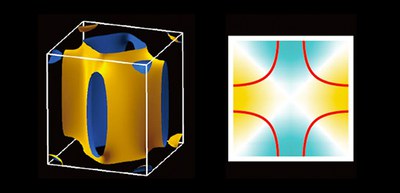
Electronic state of infinite-layer nickelate superconductors clarified
A group of researchers from Tottori University, Osaka University, Shimane University, and the National Institute of Advanced Industrial Science and Technology (AIST) has clarified the mechanisms of an infinite-layer strontium-doped neodymium nickel oxide (nickelate) superconductor (Nd,Sr)NiO2, using first-principles simulations.
Cuprates are materials comprised of superconducting layers of copper oxide (CuO2) and have the highest superconducting transition temperatures (Tc) at ambient pressure. High transition temperature (high-Tc) superconductivity arises in cuprate materials when sufficient holes or electrons are doped into the CuO2 layers of their parent compounds. In the superconducting state, two electrons form a pair (Cooper pair) due to attractive force. It is believed that, in cuprate superconductors, the attractive force is induced by ferromagnetic fluctuations.
Cooper pairs are formed in cuprate superconductors, but superconductivity is only observed in the cuprates with a 3d9 configuration and "infinite layer" structure. Thus, there is a question: If materials that have electronic structure similar to that of cuprates are discovered, will they exhibit high-Tc superconductivity?
Recently, researchers reported an infinite layer nickelate superconductor. [D. Li et al., Nature 572, 624–627 (2019)] It had been predicted that nickelate would exhibit an electronic state similar to that of cuprates, but in their report, the Tc of nickelate superconductors was far lower than that of cuprate superconductors.
Thus, in this research, the researchers performed first-principles calculations for the mother compound LaNiO2 in order to understand the reason for this low Tc. Using a multiorbital model that takes account of all the orbitals involved on the Fermi surface, the researchers estimated the effective interactions and found that they were significantly larger than those in the cuprates.
They also found that the new nickelate superconductor had a surprisingly low Tc and cuprate-like pairing. Their analytical results showed that a large intraorbital interaction suppressed Tc due to strong renormalization effects.
In addition, theoretical calculations of the electronic state of the new nickelate superconductor showed that a larger interaction within the Ni orbital along with a narrower bandwidth than in the cuprates suppressed the transition to superconductivity.
This group’s research results provide not only basic information of nickelate superconductors but also important information for understanding the nature of superconductivity at high temperatures.
Since the first-principles calculation used by this group calculates physical properties directly from basic physical quantities such as crystalline structures, the calculation method can be used for candidate compounds for superconductivity other than the new nickelate superconductor and help in the theoretical design of new superconductivity materials.
Figure 1
Figure 2
Figure 3
Figure 4
The article, “Model Construction and a Possibility of Cupratelike Pairing in a New d9 Nickelate Superconductor (Nd,Sr)NiO2,” was published in Physical Review Letters at DOI: https://journals.aps.org/prl/abstract/10.1103/PhysRevLett.125.077003.
